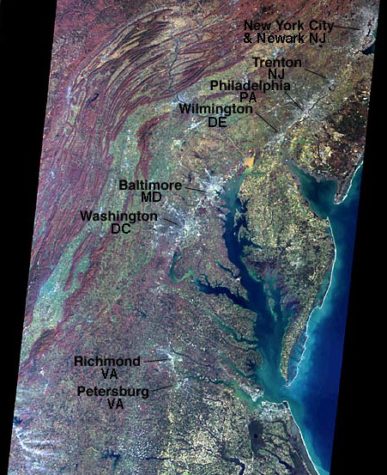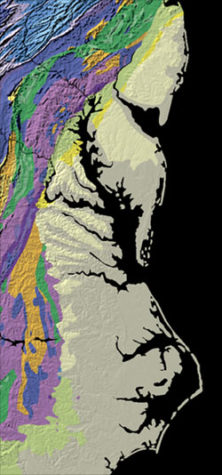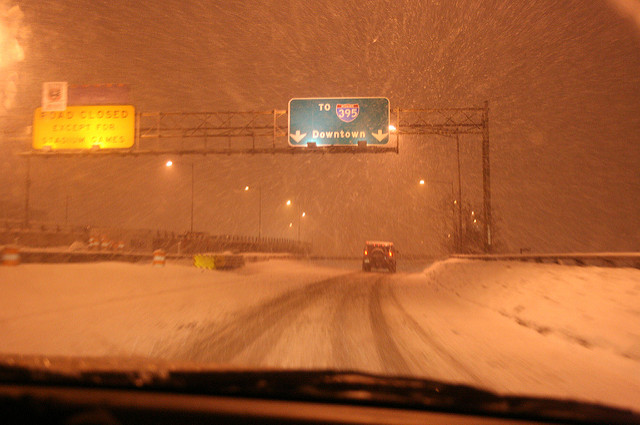Winter’s here, maybe forever, and we’re having the usual Fall Line storms. We have Fall Line storms in the summer too but winter’s are more dramatic. Because Baltimore is perched right on the Fall Line, colder to the left, warmer to the right, our normal storm is snow, then ice, then rain, then ice, then snow, not one thing, not the other, just everything taking turns and messing around. And what is the Fall Line, you say? Oh, my dears, it’s the invisible line that controls the whole east coast. This post first ran Feb. 15, 2018.
My brother and sister-in-law and I were remembering an unpleasant event fondly, as one does once it’s safely over. A few years ago, they’d been here in Baltimore and were heading back on I-95 to Philadelphia, and the usual 1.5-to-2 hour trip took 5 because a snow storm had moved over I-95 and stayed there. In our reminiscences, we noted that storms, rain or snow, seemed to follow I-95, that is, I-95 seems to be the line between one kind of weather and another. Were we making that up, we wondered? Why would weather follow an interstate? I had an ephiphany: maybe because I-95 follows the Fall Line. I am obsessed with the Fall Line, mostly because the name is so pretty.
 I-95 is the white line in this picture. It runs the length of the east coast — a terrible, kill-or-be-killed road but that’s neither here nor there — and connects the east coast’s major cities. It follows the Fall Line and the cities are dotted along the Fall Line.
I-95 is the white line in this picture. It runs the length of the east coast — a terrible, kill-or-be-killed road but that’s neither here nor there — and connects the east coast’s major cities. It follows the Fall Line and the cities are dotted along the Fall Line.
The cities and roads are where they are because of what the Fall Line is: a more or less invisible, small, underground cliff — an escarpment — that marks the old edge of the continent.
On the Fall Line’s west side, the high side, are tough crystalline rocks; on the east side, the low side, are soft, easily-moveable sediments. Rivers running out of the Appalachians east to the Atlantic crossed the cliff, and where they did, made falls. The early settlers couldn’t get their boats up the rivers past the falls, so they unloaded there and stayed put. Cities grew along the Fall Line, roads connected the cities. It’s all so logical.
But why would weather follow the Fall Line?  It doesn’t of course — because weather is much more complicated — except when it does. Earnest Googling finds South Carolina explaining the Fall Line, which it calls the Sand Hills, as the boundary between the rainy mountains and the dryer coastal plain. Georgia’s country west of the Fall Line has more rainstorms and lightning than its coast. The cities of the mid-Atlantic – Virginia, Maryland, Pennsylvania, up into New Jersey – spend their winters announcing that the western suburbs are getting buckets of snow and ice, while east of the I-95 corridor gets rain.
It doesn’t of course — because weather is much more complicated — except when it does. Earnest Googling finds South Carolina explaining the Fall Line, which it calls the Sand Hills, as the boundary between the rainy mountains and the dryer coastal plain. Georgia’s country west of the Fall Line has more rainstorms and lightning than its coast. The cities of the mid-Atlantic – Virginia, Maryland, Pennsylvania, up into New Jersey – spend their winters announcing that the western suburbs are getting buckets of snow and ice, while east of the I-95 corridor gets rain.
As I do with so many of life’s vexing questions, I turned to the Capital Weather Gang. The gang leader is named Jason Samenow and I wrote him an email. The answer took one sentence in a two-sentence email:
Hi Ann, During most precipitation events, regardless of the season or type of precipitation, it’s usually going to get a bit cooler as you go up in elevation. Does this make sense? Thanks… Jason
Higher = cooler. South Carolina’s Sand Hills are 200 to 500 feet high, the plain is 50 to 200 feet. Georgia’s elevation change is around 600 feet. That couple hundred feet of elevation difference is hardly noticeable but apparently it’s enough. “300 feet can a mean a difference of 2 critical degrees,” says Philadelphia. The hot old coastal cities all have cool old mountain resorts to their west.
As an epiphany, it’s not much. Weather follows I-95 because I-95 follows a change in elevation which accompanies a change in temperature.
Here’s a better epiphany. I lived here for decades, my office sits next to the Fall line, I routinely drive over it, and I’ve never noticed a thing. Its couple-hundred feet elevation is imperceptible. But the rivers noticed and the temperatures noticed and the weather noticed. And on this highly-populated, fast-moving east coast, the location of the cities and the roads between them, and a blind drive behind tractor-trailers tilting in the wind, all depend on an invisible escarpment.
It makes you wonder who’s really in charge around here.
____
DC snowstorm on the interstate: braidedinkwell, via Flickr; cities on I-95 on the Fall Line: University of Georgia; Fall Line geology via Wikipedia

Ann, Interesting post. I suggest you talk to Prof Russ Dickerson at UMD College Park. He can also tell you about Air pollution along the fault line.